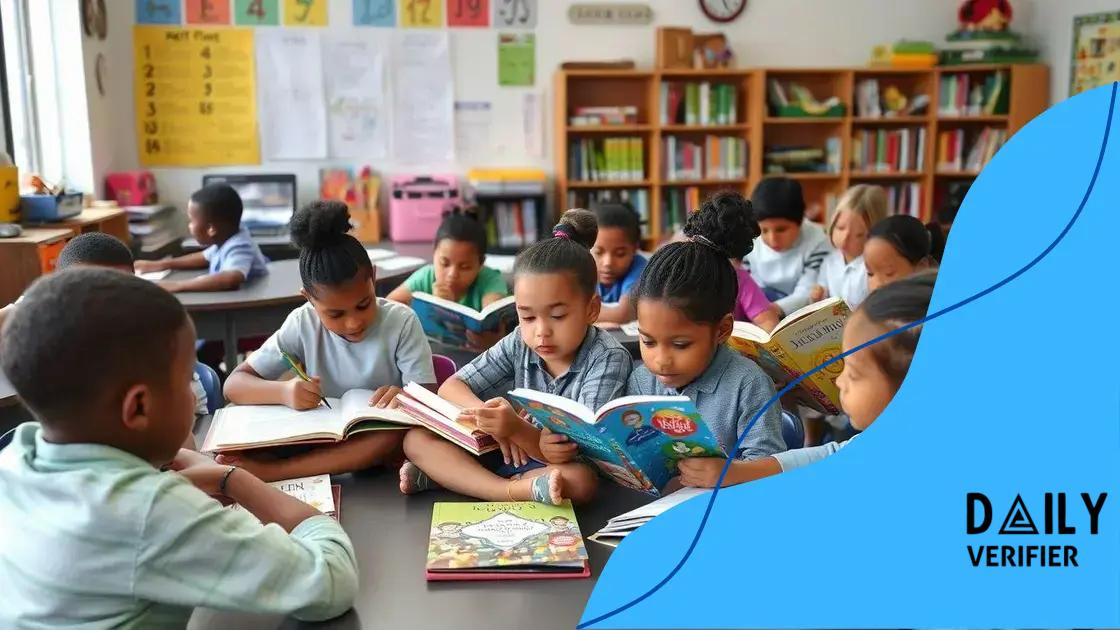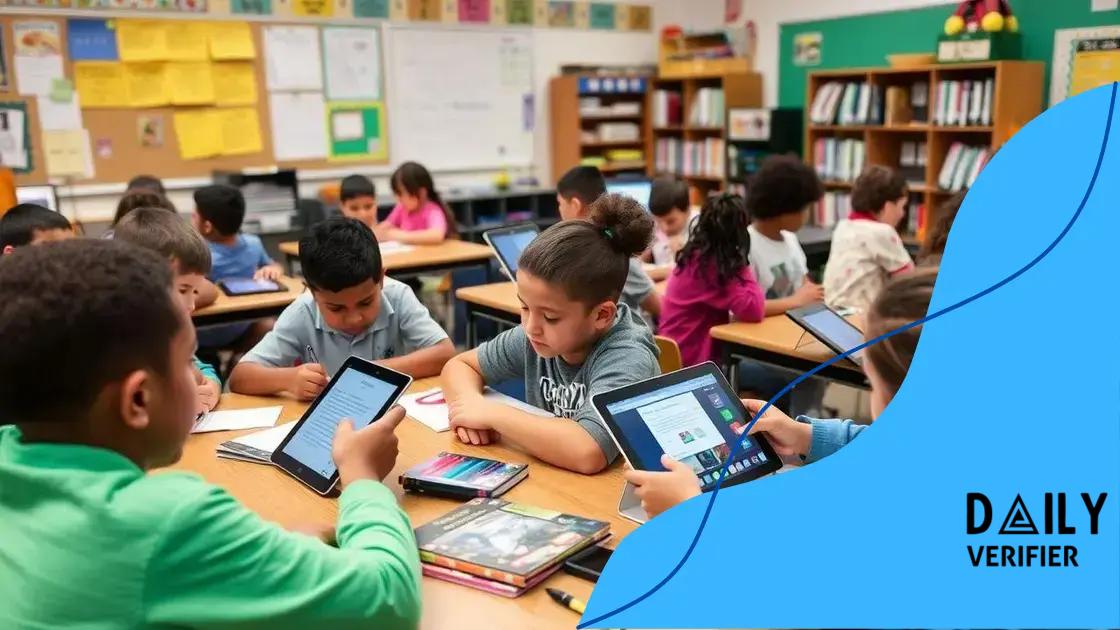Literacy bounces post-COVID: What you need to know

Community involvement, innovative strategies, and the effective use of technology are essential for enhancing literacy growth in a post-COVID world.
Literacy bounces post-COVID, revealing unexpected patterns and growth in education. Have you wondered how the pandemic reshaped reading and writing skills? Let’s explore the shifts and opportunities that emerged.
The state of literacy after COVID-19
The landscape of literacy has changed significantly after the pandemic. This transformation is important as it has both challenged and improved literacy skills for many individuals. Understanding these changes can help educators, parents, and communities better support learners.
Recent Trends in Literacy
Since the onset of COVID-19, literacy rates have seen fluctuations. Many students experienced setbacks during remote learning, yet some have thrived in personalized learning environments. Schools adapted quickly, employing various tools and resources to foster literacy. This adaptability has led to several notable trends:
- Increased use of digital resources for reading and writing.
- A rise in collaborative online learning platforms.
- Emphasis on social-emotional learning to support literacy development.
- Integration of multimedia content to engage diverse learners.
Moreover, educators have become more aware of the needs of their students. Tailoring instruction to better meet literacy goals has become a priority. This approach has led to innovative practices in teaching.
Challenges Faced
Despite the progress made, challenges remain. Many students still grapple with various obstacles that affect their literacy journey. Some of these include:
- Access to technology and the internet.
- Diverse educational backgrounds.
- Emotional impacts of the pandemic on learning.
These challenges highlight the need for ongoing support and resources dedicated to improving literacy. By addressing these areas, we can help students regain their footing.
Finally, it’s crucial to recognize the efforts of parents and caregivers. They play a vital role in enhancing their children’s literacy skills, especially during these times. Encouraging reading at home and engaging in discussions about stories can make a significant difference in literacy accomplishment.
Challenges faced in post-COVID literacy
As we examine the challenges faced in post-COVID literacy, it’s clear that the pandemic introduced significant hurdles for learners at all levels. These challenges can affect students’ ability to read and write effectively, impacting their overall academic success.
Access to Resources
A major challenge is the access to resources. Many students lacked adequate technology or internet connections during remote learning. This gap in access has created disparities in literacy development. Some students thrived with online tools, while others fell behind due to limited availability of materials.
- Many households may not have multiple devices.
- Internet access remains inconsistent in various communities.
- Public libraries and learning centers faced restrictions.
These factors have created uneven opportunities for students to engage with reading materials at home. As schools reopened, addressing this lack of resources was essential for fostering literacy growth.
Emotional and Psychological Impacts
In addition to resource challenges, students also faced emotional and psychological impacts from the pandemic. Anxiety and disruptions in routine affected many learners’ ability to focus and engage with literacy activities. Educators have recognized that addressing mental health is just as important as academic achievement.
By incorporating strategies that support students emotionally, schools can create environments better suited for learning. Engaging students through social-emotional learning can enhance their interest in literacy.
Moreover, helping students navigate their feelings about changes in the learning landscape is crucial. Building a supportive community can motivate students to embrace literacy despite ongoing challenges. Schools are working to establish safe spaces where students can express themselves and feel valued.
Innovative strategies for improving literacy

Innovative strategies for improving literacy have emerged as essential tools for educators and communities alike. These strategies aim to engage students in exciting new ways, making learning both effective and enjoyable.
Personalized Learning Approaches
One effective method is personalized learning. This approach tailors instruction to meet the needs of individual students, allowing them to progress at their own pace. By utilizing technology, teachers can create customized reading programs that adapt to each student’s level. The benefits of personalized learning include:
- Enhanced student engagement through relevant materials.
- Improved comprehension as learners can revisit challenging concepts.
- Increased motivation due to a sense of ownership over their learning.
By focusing on each student’s unique strengths and weaknesses, educators can foster a more supportive learning environment.
Incorporating Technology
In today’s digital age, incorporating technology into literacy instruction has also proven beneficial. Interactive apps and online platforms provide opportunities for students to practice reading and writing skills outside the classroom. These tools can encourage creativity and collaboration. Examples include:
- Online reading programs that offer personalized feedback.
- Collaboration tools that allow students to co-write stories.
- Multimedia resources that make lessons more engaging.
With the right technological tools, students can learn in dynamic ways that resonate with their interests and daily lives.
Creating partnerships with local libraries and community organizations can further enhance literacy programs. These partnerships provide access to resources, events, and workshops that broaden learning opportunities. When students see their community actively involved in literacy, it reinforces the importance of reading and writing skills.
The role of technology in literacy advancement
The role of technology in literacy advancement is vital in today’s educational landscape. As we adapt to new learning environments, integrating technology becomes essential for enhancing literacy skills.
Digital Literacy Tools
Digital tools have transformed how students access information and learn to read and write. With educational apps and online resources, students can engage with interactive content that makes learning more exciting. These tools can provide tailored experiences that cater to different learning styles. Some noteworthy tools include:
- Reading apps that offer personalized book recommendations.
- Writing platforms that provide real-time feedback on grammar and style.
- Interactive e-books that include quizzes and multimedia elements.
Using these types of technologies allows students to practice literacy skills in an engaging manner, making them more likely to enjoy the process of learning.
Promoting Collaboration and Communication
Technology also promotes collaboration among students, helping them develop important communication skills. By using shared documents and online platforms, students can work together on projects and enhance their understanding of literacy. For example, they can:
- Co-author stories, allowing them to learn from each other’s writing styles.
- Participate in online discussions about books they have read.
- Utilize video conferencing to discuss literary themes and ideas.
This collaborative approach not only supports literacy development but also builds social skills that are vital in today’s world.
Moreover, technology can bridge the gap for those who might struggle in traditional classroom settings. Online resources and personalized learning paths can cater to diverse needs, ensuring that all students can improve their literacy skills.
Community initiatives supporting literacy growth
Community initiatives are essential for supporting literacy growth among both children and adults. These programs create valuable resources and opportunities that enhance literacy skills and foster a love for reading and writing.
Local Libraries as Learning Hubs
Local libraries play a crucial role in promoting literacy in the community. They provide free access to books, technology, and various educational programs. Many libraries also host reading groups and workshops that engage community members. Some key features offered by libraries include:
- Storytime sessions for young children to spark their interest in reading.
- Adult literacy classes that focus on improving reading and writing skills.
- Access to online resources and databases for research and self-learning.
By offering these programs, libraries help remove barriers to accessing literacy resources.
Partnerships with Schools
Another effective approach is the collaboration between schools and community organizations. These partnerships can create programming aimed at enhancing students’ literacy skills. Community members can volunteer to assist in tutoring and mentoring students, which provides additional support outside the classroom. Examples of these initiatives include:
- After-school reading programs that pair students with mentors.
- Workshops for parents on how to encourage literacy at home.
- Book fairs and donation drives to provide books to those in need.
These efforts not only support literacy growth but also strengthen community ties.
Additionally, local businesses can contribute by sponsoring reading challenges or donating books to schools and libraries. When community members work together to foster literacy, it creates a positive ripple effect. This support system encourages individuals to prioritize reading and writing, which can make a lasting impact on their lives.
In summary, addressing the challenges of literacy in a post-COVID world requires community efforts, innovative strategies, and the effective use of technology. By strengthening partnerships between schools, libraries, and local organizations, we can create a supportive environment that promotes literacy growth for all. Encouragement from parents and community members can foster a love for reading and writing, ensuring that everyone has the opportunity to succeed. Together, we can make a lasting impact on our community’s literacy journey.
FAQ – Frequently Asked Questions about Literacy Growth
Why is community involvement important for literacy?
Community involvement creates a supportive environment that encourages reading and writing, making literacy a shared goal.
How can technology improve literacy skills?
Technology offers interactive learning tools and personalized resources, making literacy fun and accessible for all students.
What role do local libraries play in literacy advancement?
Local libraries provide access to books, educational programs, and resources that foster a love for reading in the community.
What are some effective strategies for improving literacy?
Innovative strategies include personalized learning, collaboration between schools and families, and incorporating multimedia resources.






